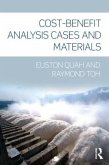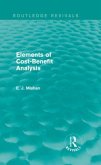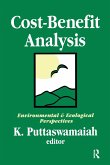- Gebundenes Buch
- Merkliste
- Auf die Merkliste
- Bewerten Bewerten
- Teilen
- Produkt teilen
- Produkterinnerung
- Produkterinnerung
This timely 6th edition of the classic Cost-Benefit Analysis text continues to build on the successful approach of previous editions, with lucid explanation of key ideas, simple but effective expository short chapters, and an appendix on useful statistical and mathematical concepts and derivatives.
Andere Kunden interessierten sich auch für
![Cost-Benefit Analysis Cost-Benefit Analysis]() Euston QuahCost-Benefit Analysis68,99 €
Euston QuahCost-Benefit Analysis68,99 €![Cost-Benefit Analysis Cost-Benefit Analysis]() Euston QuahCost-Benefit Analysis186,99 €
Euston QuahCost-Benefit Analysis186,99 €![Elements of Cost-Benefit Analysis (Routledge Revivals) Elements of Cost-Benefit Analysis (Routledge Revivals)]() E. MishanElements of Cost-Benefit Analysis (Routledge Revivals)149,99 €
E. MishanElements of Cost-Benefit Analysis (Routledge Revivals)149,99 €![The Ethics and Politics of Environmental Cost-Benefit Analysis The Ethics and Politics of Environmental Cost-Benefit Analysis]() Karine NyborgThe Ethics and Politics of Environmental Cost-Benefit Analysis166,99 €
Karine NyborgThe Ethics and Politics of Environmental Cost-Benefit Analysis166,99 €![Elements of Cost-Benefit Analysis (Routledge Revivals) Elements of Cost-Benefit Analysis (Routledge Revivals)]() E. MishanElements of Cost-Benefit Analysis (Routledge Revivals)57,99 €
E. MishanElements of Cost-Benefit Analysis (Routledge Revivals)57,99 €![Cost-benefit Analysis Cost-benefit Analysis]() James H. MeiselCost-benefit Analysis168,99 €
James H. MeiselCost-benefit Analysis168,99 €![Cost-benefit Analysis Cost-benefit Analysis]() James H. MeiselCost-benefit Analysis64,99 €
James H. MeiselCost-benefit Analysis64,99 €-
-
-
This timely 6th edition of the classic Cost-Benefit Analysis text continues to build on the successful approach of previous editions, with lucid explanation of key ideas, simple but effective expository short chapters, and an appendix on useful statistical and mathematical concepts and derivatives.
Produktdetails
- Produktdetails
- Verlag: Routledge
- 6. Auflage
- Seitenzahl: 404
- Erscheinungstermin: 10. August 2020
- Englisch
- Abmessung: 250mm x 175mm x 26mm
- Gewicht: 874g
- ISBN-13: 9781138492745
- ISBN-10: 1138492744
- Artikelnr.: 72913862
- Herstellerkennzeichnung
- Libri GmbH
- Europaallee 1
- 36244 Bad Hersfeld
- gpsr@libri.de
- Verlag: Routledge
- 6. Auflage
- Seitenzahl: 404
- Erscheinungstermin: 10. August 2020
- Englisch
- Abmessung: 250mm x 175mm x 26mm
- Gewicht: 874g
- ISBN-13: 9781138492745
- ISBN-10: 1138492744
- Artikelnr.: 72913862
- Herstellerkennzeichnung
- Libri GmbH
- Europaallee 1
- 36244 Bad Hersfeld
- gpsr@libri.de
E.J. Mishan was Professor of Economics at the London School of Economics, UK, from 1956 to 1977. Euston Quah is Albert Winsemius Chair Professor of Economics at Nanyang Technological University, Singapore.
PART I - Scope and method (1) Brief historical background to cost-benefit
analysis (2) What is cost-benefit analysis? (3) Framework to cost-benefit
analysis PART II - Basic concepts of benefits and costs (4) Measurements of
consumer surplus (5) Consumer surplus when several prices change (6)
Consumer surplus when other things change (7) Introduction to the
compensating variation (8) Measurements of rent (9) Is producer surplus a
rent? PART III - Shadow prices and transfer payments (10) Introductory
remarks (11) Opportunity cost of labour (12) Opportunity cost of unemployed
labour (13) The additional benefits of using unemployed labour (14) The
opportunity costs of imports (15) Transfer payments and double counting
PART IV - External effects (16) Introduction to external effects (17)
Adverse spillovers (18) Internalizing externalities (19) Evaluating
spillovers (20) Compensating for environmental damage PART V - Investment
criteria (21) Introduction to investment criteria (22) Crude investment
criteria (23) The discounted present value criterion (24) The internal rate
of return (25) The alleged superiority of the discounted present value
criterion compared with the internal rate of return criterion and the net
benefit ratio (26) Investment criteria in an ideal capital market (27)
Calculation of rates of return and of time preference (28) Critique of the
discounted present value criterion (I) (29) Critique of the discounted
present value criterion (II) (30) The normalized compounded terminal value
criterion (I) (31) The normalized compounded terminal value criterion (II)
(32) The Pareto criterion and generational time (33) Cost-benefit analysis,
weights and normative economics PART VI - Uncertainty (34) Risk and
certainty equivalence (35) Decision rules and heuristics (I) (36) Decision
rules and heuristics (II) (37) How practical are decision rules and
heuristics? (38) Simple probability in decision making (39) Mixed
strategies in decision making (40) Four additional strategems for coping
with uncertainty PART VII - Topics frequently encountered in cost-benefit
analysis (41) Valuation issues and methods (42) Benefit transfers (43)
Pair-wise comparison (44) Cost-benefit analysis and behavioural economics
(45) Cost-benefit analysis in developing countries (46) The value of time
(47) Measuring the benefits of recreational areas (48) Travel cost method
(49) Cost-benefit analysis and public health (50) The value of statistical
life (51) Estimating the economic cost of air pollution on health (52)
Economic cost of diseases (53) Cost-benefit analysis and the problem of
locating environmentally noxious facilities (NIMBYs): an informal
discussion PART VIII - Further notes and advanced materials (54)
Cost-benefit analysis and the economist (Appendix 1) Cost-Effectiveness
Analysis (Appendix 2) The alleged contradiction of the Kaldor-Hicks
criterion (Appendix 3) The problem of second-best (Appendix 4) Origins of
the Hicksian measures of consumer surplus (Appendix 5) Marginal curve
measures of consumer surplus (Appendix 6) The concept and measure of rent
(Appendix 7) Marginal curve measures of rent (Appendix 8) The limited
applicability of property rights (Appendix 9) Deadweight loss or love's
labour lost (Appendix 10) The value of human life (Appendix 11) The rate of
time preference (Appendix 12) Selecting a set of investment projects for
given political objectives (Appendix 13) Why cost-benefit analysis is
useful for regulatory reform (Appendix 14) Valuing household production
analysis (2) What is cost-benefit analysis? (3) Framework to cost-benefit
analysis PART II - Basic concepts of benefits and costs (4) Measurements of
consumer surplus (5) Consumer surplus when several prices change (6)
Consumer surplus when other things change (7) Introduction to the
compensating variation (8) Measurements of rent (9) Is producer surplus a
rent? PART III - Shadow prices and transfer payments (10) Introductory
remarks (11) Opportunity cost of labour (12) Opportunity cost of unemployed
labour (13) The additional benefits of using unemployed labour (14) The
opportunity costs of imports (15) Transfer payments and double counting
PART IV - External effects (16) Introduction to external effects (17)
Adverse spillovers (18) Internalizing externalities (19) Evaluating
spillovers (20) Compensating for environmental damage PART V - Investment
criteria (21) Introduction to investment criteria (22) Crude investment
criteria (23) The discounted present value criterion (24) The internal rate
of return (25) The alleged superiority of the discounted present value
criterion compared with the internal rate of return criterion and the net
benefit ratio (26) Investment criteria in an ideal capital market (27)
Calculation of rates of return and of time preference (28) Critique of the
discounted present value criterion (I) (29) Critique of the discounted
present value criterion (II) (30) The normalized compounded terminal value
criterion (I) (31) The normalized compounded terminal value criterion (II)
(32) The Pareto criterion and generational time (33) Cost-benefit analysis,
weights and normative economics PART VI - Uncertainty (34) Risk and
certainty equivalence (35) Decision rules and heuristics (I) (36) Decision
rules and heuristics (II) (37) How practical are decision rules and
heuristics? (38) Simple probability in decision making (39) Mixed
strategies in decision making (40) Four additional strategems for coping
with uncertainty PART VII - Topics frequently encountered in cost-benefit
analysis (41) Valuation issues and methods (42) Benefit transfers (43)
Pair-wise comparison (44) Cost-benefit analysis and behavioural economics
(45) Cost-benefit analysis in developing countries (46) The value of time
(47) Measuring the benefits of recreational areas (48) Travel cost method
(49) Cost-benefit analysis and public health (50) The value of statistical
life (51) Estimating the economic cost of air pollution on health (52)
Economic cost of diseases (53) Cost-benefit analysis and the problem of
locating environmentally noxious facilities (NIMBYs): an informal
discussion PART VIII - Further notes and advanced materials (54)
Cost-benefit analysis and the economist (Appendix 1) Cost-Effectiveness
Analysis (Appendix 2) The alleged contradiction of the Kaldor-Hicks
criterion (Appendix 3) The problem of second-best (Appendix 4) Origins of
the Hicksian measures of consumer surplus (Appendix 5) Marginal curve
measures of consumer surplus (Appendix 6) The concept and measure of rent
(Appendix 7) Marginal curve measures of rent (Appendix 8) The limited
applicability of property rights (Appendix 9) Deadweight loss or love's
labour lost (Appendix 10) The value of human life (Appendix 11) The rate of
time preference (Appendix 12) Selecting a set of investment projects for
given political objectives (Appendix 13) Why cost-benefit analysis is
useful for regulatory reform (Appendix 14) Valuing household production
PART I - Scope and method (1) Brief historical background to cost-benefit
analysis (2) What is cost-benefit analysis? (3) Framework to cost-benefit
analysis PART II - Basic concepts of benefits and costs (4) Measurements of
consumer surplus (5) Consumer surplus when several prices change (6)
Consumer surplus when other things change (7) Introduction to the
compensating variation (8) Measurements of rent (9) Is producer surplus a
rent? PART III - Shadow prices and transfer payments (10) Introductory
remarks (11) Opportunity cost of labour (12) Opportunity cost of unemployed
labour (13) The additional benefits of using unemployed labour (14) The
opportunity costs of imports (15) Transfer payments and double counting
PART IV - External effects (16) Introduction to external effects (17)
Adverse spillovers (18) Internalizing externalities (19) Evaluating
spillovers (20) Compensating for environmental damage PART V - Investment
criteria (21) Introduction to investment criteria (22) Crude investment
criteria (23) The discounted present value criterion (24) The internal rate
of return (25) The alleged superiority of the discounted present value
criterion compared with the internal rate of return criterion and the net
benefit ratio (26) Investment criteria in an ideal capital market (27)
Calculation of rates of return and of time preference (28) Critique of the
discounted present value criterion (I) (29) Critique of the discounted
present value criterion (II) (30) The normalized compounded terminal value
criterion (I) (31) The normalized compounded terminal value criterion (II)
(32) The Pareto criterion and generational time (33) Cost-benefit analysis,
weights and normative economics PART VI - Uncertainty (34) Risk and
certainty equivalence (35) Decision rules and heuristics (I) (36) Decision
rules and heuristics (II) (37) How practical are decision rules and
heuristics? (38) Simple probability in decision making (39) Mixed
strategies in decision making (40) Four additional strategems for coping
with uncertainty PART VII - Topics frequently encountered in cost-benefit
analysis (41) Valuation issues and methods (42) Benefit transfers (43)
Pair-wise comparison (44) Cost-benefit analysis and behavioural economics
(45) Cost-benefit analysis in developing countries (46) The value of time
(47) Measuring the benefits of recreational areas (48) Travel cost method
(49) Cost-benefit analysis and public health (50) The value of statistical
life (51) Estimating the economic cost of air pollution on health (52)
Economic cost of diseases (53) Cost-benefit analysis and the problem of
locating environmentally noxious facilities (NIMBYs): an informal
discussion PART VIII - Further notes and advanced materials (54)
Cost-benefit analysis and the economist (Appendix 1) Cost-Effectiveness
Analysis (Appendix 2) The alleged contradiction of the Kaldor-Hicks
criterion (Appendix 3) The problem of second-best (Appendix 4) Origins of
the Hicksian measures of consumer surplus (Appendix 5) Marginal curve
measures of consumer surplus (Appendix 6) The concept and measure of rent
(Appendix 7) Marginal curve measures of rent (Appendix 8) The limited
applicability of property rights (Appendix 9) Deadweight loss or love's
labour lost (Appendix 10) The value of human life (Appendix 11) The rate of
time preference (Appendix 12) Selecting a set of investment projects for
given political objectives (Appendix 13) Why cost-benefit analysis is
useful for regulatory reform (Appendix 14) Valuing household production
analysis (2) What is cost-benefit analysis? (3) Framework to cost-benefit
analysis PART II - Basic concepts of benefits and costs (4) Measurements of
consumer surplus (5) Consumer surplus when several prices change (6)
Consumer surplus when other things change (7) Introduction to the
compensating variation (8) Measurements of rent (9) Is producer surplus a
rent? PART III - Shadow prices and transfer payments (10) Introductory
remarks (11) Opportunity cost of labour (12) Opportunity cost of unemployed
labour (13) The additional benefits of using unemployed labour (14) The
opportunity costs of imports (15) Transfer payments and double counting
PART IV - External effects (16) Introduction to external effects (17)
Adverse spillovers (18) Internalizing externalities (19) Evaluating
spillovers (20) Compensating for environmental damage PART V - Investment
criteria (21) Introduction to investment criteria (22) Crude investment
criteria (23) The discounted present value criterion (24) The internal rate
of return (25) The alleged superiority of the discounted present value
criterion compared with the internal rate of return criterion and the net
benefit ratio (26) Investment criteria in an ideal capital market (27)
Calculation of rates of return and of time preference (28) Critique of the
discounted present value criterion (I) (29) Critique of the discounted
present value criterion (II) (30) The normalized compounded terminal value
criterion (I) (31) The normalized compounded terminal value criterion (II)
(32) The Pareto criterion and generational time (33) Cost-benefit analysis,
weights and normative economics PART VI - Uncertainty (34) Risk and
certainty equivalence (35) Decision rules and heuristics (I) (36) Decision
rules and heuristics (II) (37) How practical are decision rules and
heuristics? (38) Simple probability in decision making (39) Mixed
strategies in decision making (40) Four additional strategems for coping
with uncertainty PART VII - Topics frequently encountered in cost-benefit
analysis (41) Valuation issues and methods (42) Benefit transfers (43)
Pair-wise comparison (44) Cost-benefit analysis and behavioural economics
(45) Cost-benefit analysis in developing countries (46) The value of time
(47) Measuring the benefits of recreational areas (48) Travel cost method
(49) Cost-benefit analysis and public health (50) The value of statistical
life (51) Estimating the economic cost of air pollution on health (52)
Economic cost of diseases (53) Cost-benefit analysis and the problem of
locating environmentally noxious facilities (NIMBYs): an informal
discussion PART VIII - Further notes and advanced materials (54)
Cost-benefit analysis and the economist (Appendix 1) Cost-Effectiveness
Analysis (Appendix 2) The alleged contradiction of the Kaldor-Hicks
criterion (Appendix 3) The problem of second-best (Appendix 4) Origins of
the Hicksian measures of consumer surplus (Appendix 5) Marginal curve
measures of consumer surplus (Appendix 6) The concept and measure of rent
(Appendix 7) Marginal curve measures of rent (Appendix 8) The limited
applicability of property rights (Appendix 9) Deadweight loss or love's
labour lost (Appendix 10) The value of human life (Appendix 11) The rate of
time preference (Appendix 12) Selecting a set of investment projects for
given political objectives (Appendix 13) Why cost-benefit analysis is
useful for regulatory reform (Appendix 14) Valuing household production









